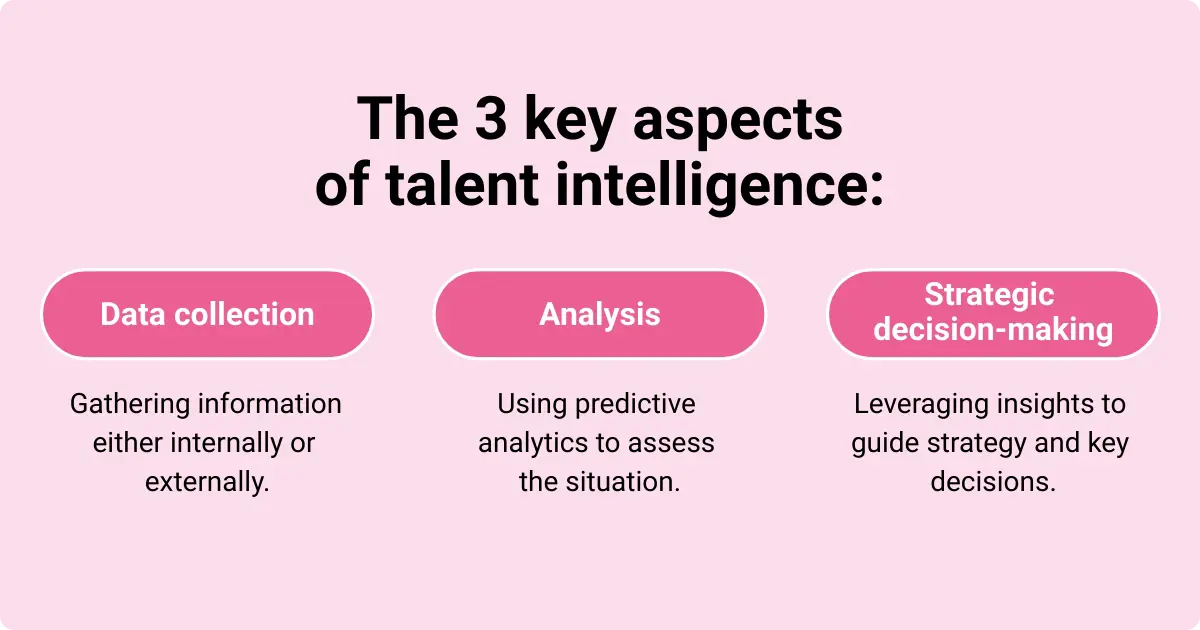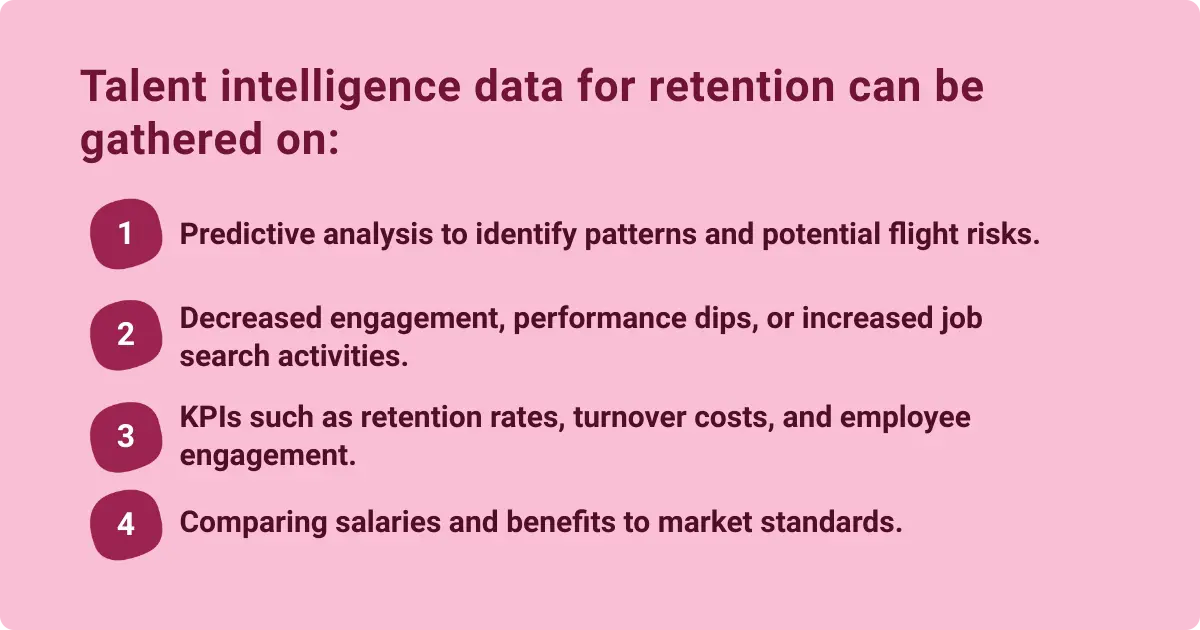What Is Talent Intelligence?: How to Optimize Your Workforce Strategy

In today’s ever-changing talent landscape, organizations must rely on something other than gut decisions to inform their workforce strategy. Talent intelligence uses internal and external data to give HR teams a competitive advantage in spotting emerging trends and finding and developing star employees.
According to the HR Executive’s blog about the 4 trends shaping talent intelligence in 2024Opens in a new tab, more than 70% of businesses plan to increase their investment in this area. But only 23% truly grasp what talent intelligence involves. Keep reading to learn how HR can leverage talent intelligence solutions to improve their talent strategy.
What is talent intelligence?
Before we get started, let’s define the term “talent intelligence.” Talent intelligence refers to data and information about your existing workforce, the external labor market, and your company’s goals. There are three key aspects of talent intelligence:
- Data collection: Gathering information either internally or externally about the category you want to make a strategic decision about.
- Analysis: Using predictive analytics to assess the situation.
- Strategic decision-making: Leveraging insights to guide strategy and key decisions.
By harnessing talent intelligence, HR teams can make data-driven decisions to identify and address talent gaps, optimize the workforce planning process, improve employee retention, and foster a more inclusive workplace that ultimately drives business growth.

Leveraging talent intelligence for strategic HR decisions
Talent intelligence can be used among a range of categories to inform strategic HR talent management decisions:
Workforce planning
Talent intelligence data can be used to predict future workforce needs based on business goals and current employee skills.
Typically, data is gathered on these metrics:
- Workforce demographics, tenure, and performance
- Cost optimization
- Workforce allocation
- Diversity and inclusion demographics
- Internal skills gaps
HR can use this data to pinpoint current and future skill gaps, optimize staffing levels, and create targeted development plans to drive career growth. This data-driven approach ensures the organization has the right talent and specific skills in place to achieve its strategic objectives and meet future goals.
Optimize workplace planning for future success with our free report on Performance in the Future of Work.
Recruitment
Talent intelligence data can revolutionize your organization’s recruitment and hiring process. By identifying certain skills that are critical for success, HR can create more accurate candidate profiles and job descriptions. Data can be gathered on:
- Labor market analysis
- Employer branding
- Recruitment channels
- Relevant internal diversity metrics
By analyzing market trends and internal data, HR can identify ideal candidate profiles, optimize job descriptions, and target specific talent pools. Predictive analytics help forecast hiring needs, while data-driven insights can guide sourcing strategies.
This can lead to a more efficient and effective talent acquisition process and attract top talent that is aligned with organizational goals.
Employee development
HR can leverage talent intelligence data to enhance employee skill development by assessing performance and tailoring development plans to better meet the needs of both the organization and the employees. Talent intelligence data can be gathered on:
- Skills gaps and capabilities
- Performance metrics
- Leadership development plans
- Succession planning insights
- Career pathing and internal mobility opportunities
HR can use this data to pinpoint high-potential individuals, create personalized career paths, and measure the impact of training programs. This data-driven approach ensures development efforts align with individual and organizational goals, fostering a skilled and engaged workforce.
Learn how you can unlock hidden talent and discover unsung future leaders within your organization with Workhuman® Cloud analytics today.
Retention
A key component of talent management strategy is keeping your high-performers happy and invested in their work at your organization. Talent intelligence data can help HR understand how to retain your best employees and stay ahead of compensation and benefit trends.
Talent intelligence data can be gathered on:
- Predictive analysis to identify patterns and potential flight risks.
- Monitor factors such as decreased engagement, performance dips, or increased job search activity to address issues proactively.
- KPIs such as retention rates, turnover costs, and employee engagement metrics.
- Compare employee salaries and benefits to market standards to ensure competitive packages.
Talent intelligence data can inform targeted retention strategies, such as personalized human resource development programs, competitive compensation, and improved work-life balance. By understanding employee needs and preferences, HR can create a positive work environment and boost retention.

Talent intelligence solutions: Tools and technologies
These solutions help HR teams ease the burden of collecting data and interpreting their data so they can get the most out of it. Let’s take a look at the various tools and technologies:
People analytics tools
People analytics are the powerhouse of HR technology solutions. These solutions gather, interpret, and analyze data on employee engagement, diversity, retention, talent gaps, and more to help organizations spot emerging trends and problem areas.
These platforms do the following:
- Collect data from various HR technology systems
- Clean and prepare data for accuracy and consistency
- Create easy-to-understand visualizations and dashboards
- Forecast future trends and outcomes based on historical data
- Recommend actions based on data insights
The data and analysis from people analytics tools can help HR make informed talent decisions that can benefit everything from employee wellbeing to culture and profits.
AI-powered skills platform
Sometimes, top talent is hiding in plain sight. What if there was a tool that could help your organization find and develop hidden rockstars? Workhuman’s AI AssistantOpens in a new tab uses data from peer-to-peer recognition and feedback messages to uncover high performers overlooked by traditional performance reviews.
Diversity recruiting platforms
Organizations need all the help they can get to create a more inclusive, equitable hiring process. Diversity recruiting platforms are useful tools that help your organization identify, attract, and hire individuals from underrepresented groups. These platforms can help reduce bias during the talent acquisition process.
These solutions help companies track diversity metrics throughout the hiring funnel to measure progress and the diversity impact on the organization so your organization can make concerted and targeted improvements.
Learning management systems (LMS)
Learning software applications are used to plan, implement, and assess workforce training. In addition to creating, managing, and delivering learning courses, learning management systems can analyze training data to measure effectiveness, the ROI of the learning program, and areas for improvement.
By tracking learner progress, engagement metrics, and course completion rates, LMS provides valuable insights to optimize training strategies and enhance overall learning outcomes.
Social media listening tools
Social media listening tools, like Hootsuite, Sprout, and Sprinklr, can give organizations insight into how the outside world perceives their brand and employee experience.
Social media listening tools use natural language processing (NLP), machine learning, and algorithms to monitor online conversations about your brand, organization, or industry across social media platforms and other online sources.
What’s posted and shared on social networks like LinkedIn and other online platforms can heavily influence or deter candidates from wanting to join your company. Gaining access to this talent intelligence data allows your organization to manage crises and change the narrative, benefitting your overall talent acquisition strategy.
Conclusion
Employee talent intelligence empowers HR to transition from gut-feel decisions to data-driven strategies. By harnessing the power of data, HR can unlock valuable insights into employee behavior, preferences, and performance, enabling organizations to streamline the employee talent assessment process. This approach helps build high-performing, engaged teams that contribute to long-term business success.
About the author
Alicyn Zall
Alicyn Zall is a writer dedicated to creating a more equitable and fulfilling workplace. With a focus on actionable, data-driven insights, her work empowers individuals and organizations to foster positive change. In addition to her contribution at Workhuman, Alicyn has served as an editor at Harvard Business Review where she developed books and articles about mental health and the future of work.